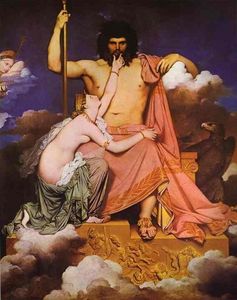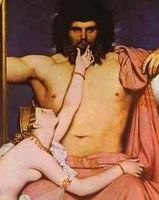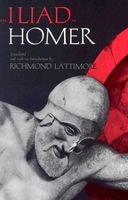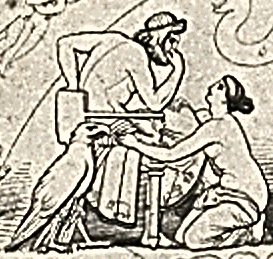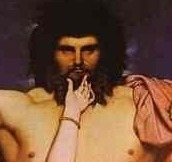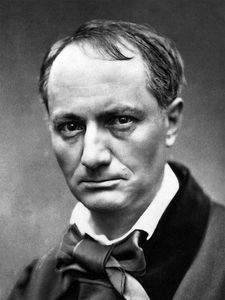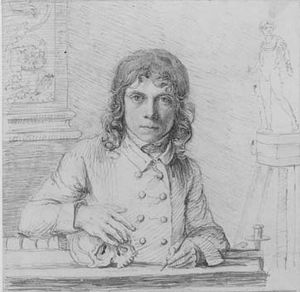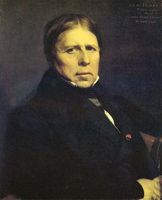Jupiter and Thetis
- Date of Creation:
- 1811
- Height (cm):
- 345.00
- Length (cm):
- 257.00
- Medium:
- Oil
- Support:
- Canvas
- Subject:
- Fantasy
- Art Movement:
- Neoclassicism
- Created by:
- Current Location:
- Aix-en-Provence, France
- Displayed at:
- Musée Granet
- Owner:
- Musée Granet
Jupiter and Thetis Story / Theme
Ingres brings the words of Homer's Iliad to life in his depiction of Jupiter and Thetis. In this scene of Mount Olympus, Thetis, a mere nymph (a class of lesser deities of mythology, conceived of as beautiful maidens inhabiting the sea rivers, woods, trees, mountains, meadows) pleads with the mighty God, Jupiter, for the life of her son Achilles. She begs him to intervene by making the Greeks repent of their injustice to Achilles by granting success to the enemy Trojan army.
Ingres contrasts the two characters beautifully. He displays the corporal qualities he sees fitting for each gender; Jupiter possesses a hard muscular body to Thetis' sensuous, voluptuous curves. Their body language is also in sharp defiance; he sits firm and erect like a statue, she contorts her body like a snake. Emotion pours over her face, exuding from each limb. Jupiter looks straight ahead with no readable emotion on his face. He displays an evasive pose, with both his arms and legs spread broadly across the canvas. Thetis makes as much contact with his body as possible while he makes no effort to touch her.
True to Ingres style, he adds both obvious and subtle elements of eroticism. Each point of contact her skin makes to the god's is poignant. Her left hand fondles his beard while her right lays across his lap suggesting an erotic caress. She rests her breasts on his thigh and her toe lightly caresses his. Her attempts to appear modest are shrugged away as her clothes fall off her slithering body. All the while Juno, Jupiter's wife, peers in from the left to see what's going on.
Jupiter and Thetis Inspirations for the Work
As with many artists of the day, Ingres drew greatest inspiration for Jupiter and Thetis from the pages of Homer's Iliad. He brings to life a specifically poignant scene in which Thetis begs for the life of her son Achilles. Though he doesn't stray from the text (besides the reversal of hand positions), Ingres adds his own personal touch of eroticism, more than indicated in the word's Homer penned. Other artists such as John Flaxman have put imagery to Homer's text but it is not known whether Ingres drew inspiration from such works.
The Iliad:
The crowning inspiration for Jupiter and Thetis comes from Homer's Iliad. Ingres brings the literal translation of the text into a fascinating two-dimensional form, emotions and reactions included. He creates a full picture between the characters, defining an image of the transaction Homer wrote about in his epic novel.
Another Jupiter and Thetis:
This same theme has been seen in other art, such as the 1793 engraving by John Flaxman, also entitled Jupiter and Thetis. The pleading Thetis is also nude as she kneels beside Jupiter but Flaxman's representation of the God differs from Ingres. He leans into the nymph, his body language revealing his thoughts more than Ingres' stark and serious portrayal of the God. Both artists include an eagle in their work.
Jupiter and Thetis Analysis
Out of all the work Ingres created during his 87 years, he considered Jupiter and Thetis his ultimate masterpiece. Ingres displayed two of his favorite subjects, history and the female nude, through a brilliant and direct composition. His use of colors plays a part in contrasting the emotions of both of Homer's characters of the Iliad.
Composition:
Jupiter's broad, confident body takes up nearly the entire canvas for a reason. His stature, poised yet relaxed, shows the weight of his importance in this scene. It is solely his decision whether or not Achilles lives or dies. The slithering Thetis seems small and insignificant in comparison to the deity.
Use of Color:
Under the classical training of David, Ingres was taught to focus more on drawing than color. Though he paid meticulous attention to the details of the line, his use of colors is also carefully planned. In Jupiter and Thetis he utilizes a lurid color palette. The green of Thetis' cloth sharply clashes with Jupiter's red cloth. Perhaps Ingres was trying to show further contrast between the characters so as to exemplify their differences.
Lighting:
Like most of Ingres' figures, Jupiter and Thetis are heavily outlined. Jupiter's arm is outlined though it is freestanding in the open sky, with no background to cause such a contrast. The bodies of the figures lack in modeling except on their outer rims. This was a technique of Ingres' that critics loved to attack.
Emotions elicited:
The emotion portrayed by the pleading mother, Thetis, cannot be overlooked. She makes a desperate attempt to save her son Achille's life, employing erotic and sensual gestures to have her request granted. She looks straight up at the unyielding god with the passion only a beggar's eyes can contain. Her lips are tight with anticipation of the answer, almost as if she prepares for the thanks which will spill from her lips if he greants her plea. Her body is draped over him.
Jupiter on the other hand sits confidently, seemly unmoved by her supplications. He stares ahead almost as if he barely notices her touches, let alone her presence.
Brushstroke:
Ingres used tight brushwork to achieve his smooth surface.
Jupiter and Thetis Critical Reception
Ingres may have considered Jupiter and Thetis his ultimate masterpiece but critics of his day did not agree. The initial reception of this piece marked a long period of disapproval from 19th century critics. Today, however this work of art is recognized for its worth, as bystanders who have seen the culmination of Ingres' long career. They view this piece not just for its artistic vision of grandiose but also for the sexual nature Ingres displayed time and time again throughout his career.
Contemporary Reception:
Some art historians of today like to exemplify what they consider the most important part of Ingres work, his erotic features. In his text, Ingres: Erotic Drawings, Stephane Guegan strongly suggests that Ingres was more a sexual being than a perfectionist. He hints that Ingres quest for "ideal beauty" and his anatomical distortions were really just ways to further display the sexual purposes of his figures. Other critics agree. Baudelaire described him as a painter of "profound sensual delight."
Posthumous Reception:
Not much is said specifically about the posthumous reception of Jupiter and Thetis. It is known that after Ingres' death, Neoclassicism was overtaken by romanticism. It wasn't until the early 20th century that interest in any of Ingres' work was triggered once again.
Jupiter and Thetis Related Paintings
Jupiter and Thetis Locations Through Time - Notable Sales
After its outright rejection at the 1811 Salon, Jupiter and Thetis remained in Ingres' studio until it was purchased by the state in 1834. It now currently resides in the Musée Granet, in Aix-en-Provence, France.
Jupiter and Thetis Artist
Ingres had a long career, painting well into his 80s. He experienced bad reviews and praise from critics in equally strong capacities. In Italy, Jupiter and Thetis was among the works Ingres completed and sent back to the officials at the École in Paris where it was heavily criticized for the anatomical distortions of his figures. True to Ingres style, in Jupiter and Thetis he adds both obvious and subtle elements of eroticism. Each point of contact Thetis' skin makes to Jupiter's is poignant. Despite criticism of this piece, Ingres remained a leader in the Neoclassical movement and he went on to inspire many great artists including Picasso and Matisse.
Jupiter and Thetis Art Period
Neoclassicism is the 18th century revival of classical beliefs. It differs from other revivals as Neoclassical artists approached the ancient subject with a newer, more scientific approach. They also combined an interest in both ancient worlds; Greece and Rome.
The artifacts uncovered at Pompeii and Herculaneum contributed significantly to this rebirth of classicism. Artists like Ingres portrayed the absolute truth of life through the "pure and simple" verities of antiquity. Neoclassicism replaced the frivolity and superficiality of the Rococo era.
Jupiter and Thetis Bibliography
Read more about Neoclassicism and Ingres' works by referring to the sources listed below.
• Boime, Albert. Art in an Age of Bonapartism, 1800-1815. Chicago: Chicago University Press, 1993
• Fisher, Jay M. The Essence Of Line: French Drawings From Ingres To Degas. Pennsylvania: Pennsylvania State University Press, July, 2005
• Grimme, Karin H. Jean Auguste Dominique Ingres: Taschen Basic Art. New York: TASCHEN, December, 2006
• Vigne, Georges. Ingres. London: Abbeville Press, Incorporated. October, 1995

